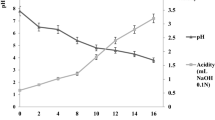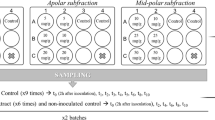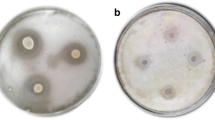Abstract
Purpose
The antimicrobial properties of Mexican oregano (Lippia berlandieri Schauer) essential oil have been well documented; but its extraction process generates large amounts of agro-industrial wastes. This material can be used as support-substrate in solid-state fermentation, to release and/or accumulate molecules with industrial application. Therefore, the aim of this work was to evaluate the microbial effect of products derived from solid state fermentation of Mexican oregano waste by Aspergillus niger PSH.
Methods
Microbial activity was tested by well diffusion test of aqueous and non-polar extracts from solid state fermentation, against fungi, foodborne pathogens and spoilage bacteria, as well as Lactic Acid Bacteria. Further, growth curves were done with Listeria monocytogenes and Lactobacillus lactis to describe the possible effect of extracts on bacterial growth.
Results
Polar and non-polar extracts from solid state fermentation had no deleterious effect against tested fungi and food-borne pathogenic bacteria (Escherichia coli O157:H7, Staphylococcus aureus, Salmonella enterica subgroup enterica subsp. Tiphymurium). Aqueous extract, at concentrations higher than 2.5 % had a bacteriostatic effect on L. monocytogenes. Lactic acid bacteria showed a growth increment in culture medium complemented with aqueous extracts, and this effect was confirmed by microbial growth curves.
Conclusions
Non polar extracts had no antimicrobial effect. Aqueous extracts had a bacteriostatic effect in L. monocytogenes and promote the lactic acid bacteria growth; this extracts can be used as prebiotic or growth-enhancing supplement for lactic acid bacteria, but further research is needed.


Similar content being viewed by others
References
Silva-Vázquez, R., Gastélum-Franco, M.G., Torres-Muñoz, J.V., Nevárez-Moorillón, G.V.: Las especies de orégano en México. In: Aguilar, C.N. (ed.) Fitoquímicos Sobresalientes del Semidesierto Mexicano: de la planta a los químicos naturales y a la biotecnología, pp 136–153. Path Design, México. 579 páginas. (2008)
Arcila-Lozano, C.C., Loarca-Piña, G., Lecona-Uribe, S., González-de-Mejía, E.: El orégano: propiedades, composición y actividad biológica de sus componentes. ALAN 54(1), 100–111 (2004)
Dunford, N.T., Silva-Vazquez, R.: Effect of water stress on plant growth and thymol and carvacrol concentrations in Mexican oregano grown under controlled conditions. J. Appl. Hort. 7, 20–22 (2005)
Avila-Sosa, R., Gastélum-Franco, M.G., Camacho-Dávila, A., Torres-Muñoz, J.V., Nevárez-Moorillón, G.V.: Extracts of Mexican oregano (Lippia berlandieri Schauer) with antioxidant and antimicrobial activity. Food Bioprocess Tech. 3, 434–440 (2010)
Paredes-Aguilar, M.C., Gastélum-Franco, M.G., Silva-Vázquez, R., Nevárez-Moorillón, V.G.: Efecto antimicrobiano del orégano mexicano (Lippia berlandieri Schauer) y de su aceite esencial sobre cinco especies del género Vibrio. Revista Fitotecnia Mexicana 30(3), 261–267 (2007)
Rangel, S., Hernández, M., Silva, R., Ruelas, X., López, R.: Aplicación del aceite esencial de orégano (Lippia berlandieri Schauer) como antimicrobiano contra patógenos alimenticios. http://www.respyn.uanl.mx/especiales/2008/ee-01-2008/index.html (2008). Accessed 16 Sept 2012
Portillo-Ruiz, M.C., Viramontes-Ramos, S., Gastélum-Franco, M.G., Muñoz-Castellanos, L.N., Nevárez-Moorillón, G.V.: Antifungical activity of Mexican oregano (Lippia berlandieri Schauer). J. Food Prot. 68(12), 2713–2717 (2005)
Ávila-Sosa, R., Hernández-Zamoran, E., López-Mendoza, I., Palou, E., Jiménez-Munguía, M.T., Nevárez-Moorillón, G.V., López-Malo, A.: Fungal inactivation by Mexican oregano (Lippia berlandieri Schauer) essential oil added to amaranth, chitosan, or starch edible films. J. Food Sci. 75, 127–133 (2010)
Orzua, M.C., Mussatto, S.I., Contreras-Esquivel, J.C., Rodriguez, R., De la Garza, H., Teixeira, J.A., Aguilar, C.N.: Exploitation of agro industrial wastes as immobilization carrier for solid-state fermentation. Ind. Crops Prod. 30, 24–27 (2009)
Hölker, U., Höfer, M., Lenz, J.: Biotechnological advantages of laboratory-scale solid-state fermentation with fungi. Appl. Microb. Biotechnol. 64, 175–186 (2004)
Pandey, A., Soccol, C.R., Mitchell, D.: New developments in solid state fermentation: I-bioprocesses and products. Proc. Biochem. 35, 1153–1169 (2000)
Singhania, R.R., Patel, A.K., Soccol, C.R., Pandey, A.: Recent advances in solid-state fermentation. Biochem. Eng. J. 44, 13–18 (2009)
Garlapati, V.K., Banjerjee, R.: Optimization of lipase production using differential evolution. Biotechnol. Bioproc. Eng. 15(2), 254–260 (2010)
Kempka, A.P., Lipke, N.L., da Luz Fontoura Pinheiro, T., Menoncin, S., Treichel, H., Treichel, M.D., de Oliveira, D.: Response surface method to optimize the production and characterization of lipase from Penicillum verruscosum in solid-state fermentation. Bioproc. Biosys. Eng. 31(2), 119–125 (2008)
Danesh, A., Mamo, G., Mattiasson, B.: Production of halodarucin by Bacillus halodurans using solid-state fermentation. Biotechnol. Lett. 33(7), 1339–1344 (2011)
Soccol, C.R., Vandenberghe, L.P.S., Rodrigues, C., Pedroni Medeiros, A.B., Larroche, C., Pandey, A.: Production of organic acids by solid-state fermentation. In: Pandey, A., Soccol, C.R., Larroche, C. (eds.) Current developments in solid-state fermentation part 2, pp. 205–229. Springer, India (2008)
Meléndez-Rentería, P., Nevárez-Moorillon, G.V., Rodríguez-Herrera, R., Aguilar, C.N.: Solid state fermentation of Mexican oregano (Lippia berlandieri Schauer) waste. Am. J. Agric. Biol. Sci. 7(1), 76–81 (2012)
Cruz-Hernández, M., Contreras-Esquivel, J.C., Lara, F., Rodríguez, R., Aguilar, C.N.: Isolation and evaluation of tannin-degrading fungal strains from the Mexican desert. Z. Naturfors. 60, 844–848 (2005)
Oliveira, D.R., Leitão, G.G., Bizzo, H.R., Lopes, D., Alviano, D.S., Aliviano, C.S., Leitão, S.G.: Chemical and antimicrobial analyses of essential oil of Lippia origanoides H.B.K. Food Chem. 101, 236–240 (2007)
Hernández, T., Canales, M., García, A.M., Durán, A., Meráz, S., Dávila, P., Ávila, J.G.: Antifungal activity of the essential oils of two Verbenaceae: Lantana achyranthifolia and Lippia graveolens of Zapotitlan de las Salinas, Puebla (México). Boletín Latinoamericano y del Caribe de Plantas Medicinales y Aromáticas 7(4), 203–207 (2008)
El-Gendy, M.M.A.: Keratinase production by endophytic Penicillium spp. Morsy 1 under solid-state fermentation using rice straw. Appl. Biochem. Biotechnol. 162, 780–794 (2010)
Martínez-Hernández, J.L., Mata-Gómez, M.A., Aguilar-González, C.N., Ilyina, A.: A process to produce penicillin G acylase by surface-adhesion fermentation using Mucor griseocyanus to obtain 6-Aminopenicillanic acid by penicillin G hydrolysis. Appl. Biochem. Biotechnol. 160, 2045–2053 (2010)
Kurakov, A.V., Khidirov, K.S., Sadykova, V.S., Zvyagintsev, D.G.: Aerobic growth ability and alcohol fermentation activity of microscopic fungi. Appl. Biochem. Microbiol. 47(2), 169–175 (2011)
Sewal, M.K., Yadav, A., Selwal, K.K., Aggarwal, N.K., Gupta, R., Gautam, S.K.: Production by Penicillum atramentosum KM under SSF and its applications in wine clarification and tea cream solubilization. Brazilian J. Microbiol. 42, 374–387 (2011)
Yegin, S., Fernandez-Lahore, M., Gama Salgado, A.J., Guvenc, U., Goksungur, Y., Tari, C.: Aspartic proteinases from Mucor spp. in cheese manufacturing. Appl. Microbiol. Biotechnol. 89, 949–960 (2011)
Lambert, R.J.W., Skandamis, P.N., Coote, P.J., Nychas, G.-J.E.: A study of the minimum inhibitory concentration and the mode of action of oregano essential oil, thymol and carvacrol. J. Appl. Microbiol. 91, 453–462 (2001)
Ultee, A., Bennik, M.H.J., Moezelaar, R.: The phenolic hydroxyl group of carvacrol is essential for the action against the food-borne pathogen Bacillus cereus. Appl. Environ. Microbiol. 68(4), 1561–1568 (2002)
Philip, K., Kumar Sinniah, S., Muniandy, S.: Antimicrobial peptides in aqueous and ethanolic extracts from microbial, plant and fermented sources. Biotechnology 8(2), 248–253 (2009)
Lee, H.C., Jenner, A.M., Seng Low, C., Kun Lee, Y.: Effect of tea phenolics and their aromatic fecal bacterial metabolites on intestinal microbiota. Res. Microbiol. 157, 876–884 (2006)
Halliwell, B., Rafter, J., Jenner, A.: Health promotion by flavonoids, tocopherols, tocotrienols, and phenols: direct or indirect effects? Antioxidant or not? Am. J. Clin. Nutr. 81, 268S–276S (2005)
Zavala-Nigoa, J., Loarca-Piña, G., García-Gasca, T.: Evaluación del contenido fenólico, capacidad antioxidante y actividad citotóxica sobre células CaCo-2 del extracto acuoso de orégano (Lippia graveolens Kunth). 2do congreso nacional de química médica. http://docs.google.com/viewer?a=v&q=cache:Kde8BMjZWq0J:www.respyn.uanl.mx/especiales/2007/ee-07-2007/documentos/trabajos_libres/110_zavala-nigoa_y_col..pdf+Evaluaci%C3%B3n+del+contenido+fen%C3%B3lico,+capacidad+antioxidante+y+actividad+citot%C3%B3xica+sobre+c%C3%A9lulas+CaCo-2+del+extracto+acuoso+de+or%C3%A9gano+(Lippia+graveolens+Kunth).&hl=es&gl=mx&pid=bl&srcid=ADGEESh93yyLj7HT3o1hkZAJ-M9ZT2tfluLGxL37pzDAGYTanIr-n8MECPyYgW49YAf0WZbnZ-mdK0_PHdHCvmYxsXWsiSd5psssOrUDftnOnR72Ie5Y28o06QBdRgi59wKUyQdPwjf6&sig=AHIEtbRtz1ITZ9gizfvzlhrr76GyYqUUBw (2006). Accessed 16 Sept 2012
Gupta, J., Siddique, Y.H., Beg, T., Ara, G., Afzal, M.: A review on the beneficial effects of tea polyphenols on human health. Int. J. Pharmacol. 4(5), 314–338 (2008)
De Araujo Chagas Vergara, C.M., Lopes Honorato, T., Arraes Maia, G., Rodrigues, S.: Prebiotic effect of fermented cashew Apple (Anacardium occidentale L.) juice. LWT-Food Sci. Technol. 43, 141–145 (2010)
Kalui, C.M., Mathara, J.M., Kutima, P.M.: Probiotic potential of spontaneously fermented cereals based foods—a review. Afr. J. Biotechnol. 9(17), 2490–2498 (2010)
Acknowledgments
Author Meléndez-Rentería wants to thank to the Mexican Council of Science and Technology (CONACYT) for the scholarship to carry out her postgraduate program in Food Science and Technology.
Author information
Authors and Affiliations
Corresponding author
Rights and permissions
About this article
Cite this article
Meléndez Rentería, P., Rodríguez Herrera, R., Aguilar, C.N. et al. Microbiological Effect of Fermented Mexican Oregano (Lippia berlandieri Schauer) Waste. Waste Biomass Valor 5, 57–63 (2014). https://doi.org/10.1007/s12649-013-9222-2
Received:
Accepted:
Published:
Issue Date:
DOI: https://doi.org/10.1007/s12649-013-9222-2




